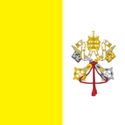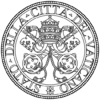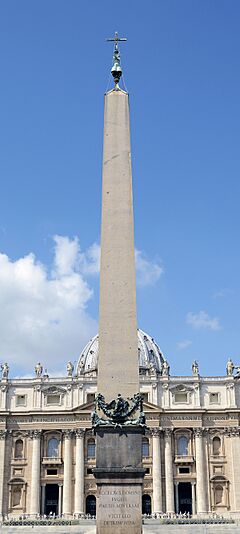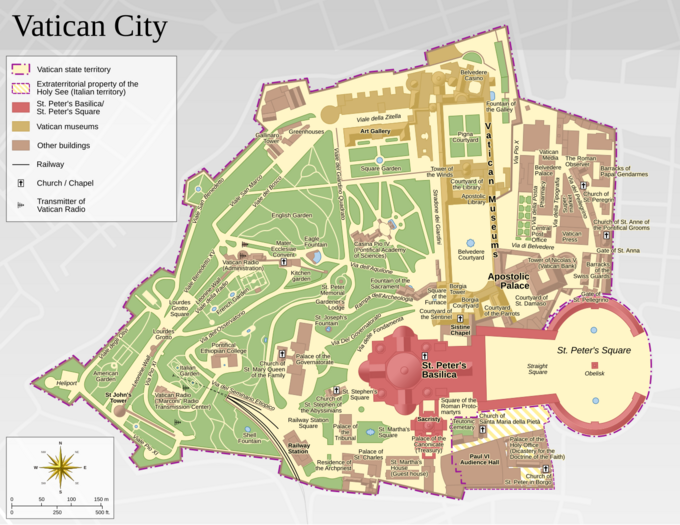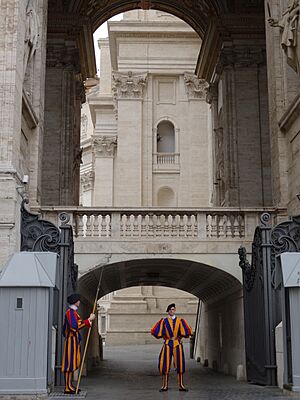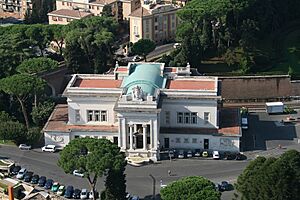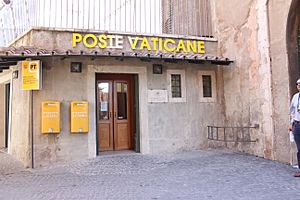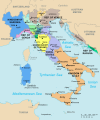Vatican City facts for kids
Quick facts for kids
Vatican City State
|
|
|---|---|
|
|
|
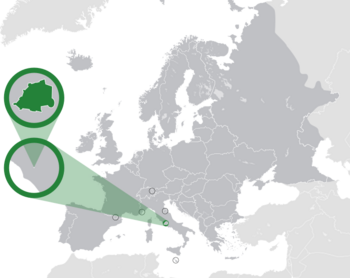
Location in Italy
|
|
| Capital | Vatican City (city-state) 41°54.2′N 12°27.2′E / 41.9033°N 12.4533°E |
| Official languages | Italian |
| National language | Latin (de jure) Italian (de facto) |
| Religion | Catholicism (state religion) |
| Demonym(s) | None (de jure) Vatican (de facto) |
| Government | Unitary theocratic Catholic elective absolute monarchy |
| Holy See | |
|
• Pope
|
Sede vacante |
|
• Camerlengo
|
Kevin Farrell |
| Legislature | Pontifical Commission |
| Independence
from the Kingdom of the Franks and Italy
|
|
|
• Donation of Pepin
|
756 (1269 years ago) |
| 11 February 1929 (96 years ago) | |
| Area | |
|
• Total
|
0.49 km2 (0.19 sq mi) (195th) |
| Population | |
|
• 2024 estimate
|
882 (237th) |
|
• Density
|
1,800/km2 (4,662.0/sq mi) (7th) |
| GDP (PPP) | 2021 estimate |
|
• Total
|
€14,859,970 |
|
• Per capita
|
€19,450.22 |
| Currency | Euro (€) (EUR) |
| Time zone | UTC+1 (CET) |
|
• Summer (DST)
|
UTC+2 (CEST) |
| Driving side | right |
| Calling code | +379 |
| ISO 3166 code | VA |
| Internet TLD | .va |
| UNESCO World Heritage Site | |
|---|---|

Vatican City
|
|
| Criteria | Cultural: i, ii, iv, vi |
| Inscription | 1984 (8th Session) |
Vatican City, officially called the Vatican City State, is a very small country in Europe. It is a landlocked city-state, meaning it is a city that is also its own country, and it's completely surrounded by the city of Rome, Italy. It's the smallest country in the world by both size and population!
Vatican City became independent from Italy in 1929. It is a special territory owned and governed by the Holy See, which is the central government of the Catholic Church. The Holy See helps the city-state manage its government and international relations. The Vatican is also a nickname for the Pope, who is the leader of the Catholic Church.
Even though it's tiny, Vatican City is home to famous religious and cultural places. These include St. Peter's Basilica, the Sistine Chapel, and the Vatican Museums. These places hold some of the world's most amazing paintings and sculptures. The country's economy is supported by donations, selling stamps and souvenirs, and museum tickets.
Contents
What's in a Name?
The name Vatican City was first used in 1929. This was when the Lateran Treaty was signed, making it a modern city-state. The name comes from Vatican Hill, which is where the state is located in Rome.
The word "Vatican" comes from an old Etruscan settlement. The Romans called this area Ager Vaticanus, meaning "Vatican territory." In Italian, the city's name is Città del Vaticano. In Latin, it's Status Civitatis Vaticanae, used in official church documents.
A Look Back in Time
How Vatican City Started
The area known as "Vatican" was a marshy land near the Tiber River in ancient Rome. Romans thought this area was not good because it often flooded.
Later, in the 1st century AD, Agrippina the Elder created gardens here. Her son, Emperor Caligula, built a circus for chariot races. This was later finished by Nero and was called the Circus of Nero.
The Vatican obelisk in St. Peter's Square is a reminder of this ancient circus. It was brought from Egypt by Emperor Caligula. Many Christians were martyred here after the Great Fire of Rome in AD 64. It is believed that Saint Peter was crucified upside-down in this circus.
A cemetery was located near the circus. Many tombs and monuments were built there. In 326 AD, the first basilica was built over what was thought to be the tomb of Saint Peter. From then on, more people lived in the area around the basilica.
Popes and Their Lands
For over a thousand years, Popes ruled large areas of central Italy known as the Papal States. However, they didn't always live at the Vatican. For a long time, their home was the Lateran Palace on the other side of Rome. From 1309 to 1377, they even lived in France.
When the Popes returned to Rome, they chose to live at the Vatican. But in 1870, the new Kingdom of Italy took over all the Pope's lands, including Rome. This left the Pope without a country.
Becoming Independent
After 1870, the Pope was like a "prisoner in the Vatican". He refused to leave the Vatican walls because he didn't recognize Italy's rule over Rome. This problem was called the "Roman Question."
This situation was finally solved on February 11, 1929. The Lateran Treaty was signed between the Holy See and the Kingdom of Italy. This treaty created the independent state of Vatican City. It also confirmed the special role of the Catholic Church in Italy.
Vatican City in World War II
During World War II, Vatican City remained neutral. This meant it did not take sides in the war. Even when German troops occupied Rome, both sides respected Vatican City's neutrality.
Pope Pius XII worked hard to prevent the city from being bombed. He even protested when pamphlets were dropped over Rome, saying it violated the Vatican's neutrality. The Allies, including the US and Britain, generally tried to avoid bombing Rome and the Vatican.
On July 19, 1943, Allied planes bombed Rome, targeting railway hubs. About 1,500 people died. Pope Pius XII visited the affected areas. The next day, Rome was declared an "open city," meaning it would not be defended, to try and prevent more bombings.
Where is Vatican City?
Vatican City is located on Vatican Hill in Rome. It includes St. Peter's Basilica, the Apostolic Palace, the Sistine Chapel, and the Vatican Museums. The area was protected by walls built by different Popes over centuries.
When Vatican City was created in 1929, its borders were set by these existing walls and buildings. St. Peter's Square is part of Vatican City, but it's separated from Italy by just a white line. The famous Via della Conciliazione leads from the Tiber River to St. Peter's.
Some buildings belonging to the Holy See are outside Vatican City but still have special status. These include the Papal Palace of Castel Gandolfo and major basilicas in Rome. They are treated like foreign embassies.
Visitors can freely enter St. Peter's Square and Basilica. The Vatican Museums usually charge an entrance fee. Guided tours can be arranged for the Vatican Gardens and the ancient tombs under the basilica.
Weather in Vatican City
Vatican City has a Mediterranean climate, just like Rome. This means it has mild, rainy winters from October to May. Summers, from May to September, are hot and dry. The large St. Peter's Basilica and fountains can cause some local mists.
The Vatican is also working to be more eco-friendly. In 2008, it started a recycling program. In 2019, it announced a ban on single-use plastics. The goal is to recycle 70-75% of its waste.
Beautiful Gardens
About half of Vatican City is covered by the Vatican Gardens. These gardens were created during the Renaissance and Baroque era. They are filled with beautiful fountains and sculptures.
The gardens cover about 23 hectares (57 acres). The highest point is 60 meters (197 feet) above sea level. Stone walls surround the gardens on three sides.
The gardens date back to medieval times. In 1279, Pope Nicholas III moved his home back to the Vatican and built walls around this area. He planted an orchard, a lawn, and a garden.
How Vatican City is Run
Vatican City is an absolute elective monarchy. This means the Pope, who is the head of the Catholic Church, has all the power. He is chosen by other cardinals, not born into the role.
The Pope's Role

The Pope is the head of state for Vatican City. This role comes from his main job as the Bishop of Rome and leader of the Catholic Church. The term "Holy See" refers to the Pope's spiritual leadership, not just the state itself.
Pope Francis, born Jorge Mario Bergoglio, was elected Pope on March 13, 2013. The main official who helps the Pope run Vatican City is the President of the Pontifical Commission for Vatican City State. This person is like the head of government.
Keeping the Peace
Vatican City is a neutral state, so it doesn't have its own army. Italy provides its military defense. However, the Swiss Guard is a special military group of the Holy See. They are responsible for the Pope's personal safety and security within the state.
Swiss Guards are Catholic, unmarried men from Switzerland. They must be between 19 and 30 years old and at least 174 cm (5 ft 8 in) tall. They are trained in bodyguard tactics and carry traditional weapons like the halberd.
The Corps of Gendarmerie of Vatican City acts as the police and security force for Vatican City. They handle security, public order, traffic, and investigations. They also help provide security for the Pope outside Vatican City.
The Corps of Firefighters of the Vatican City State is the fire department. They respond to fires, floods, and other emergencies.
Talking to Other Countries
Vatican City does not have its own diplomatic service. Instead, the Holy See handles all its foreign relations. Because Vatican City is so small, foreign embassies to the Holy See are located in Rome, Italy.
Vatican City State is a member of some international groups. These groups deal with things like postal services, telecommunications, and intellectual property.
How Vatican City Makes Money
Vatican City's budget comes from several sources. These include selling stamps, coins, medals, and souvenirs. Money also comes from museum admission fees and selling publications.
The Institute for Works of Religion, also known as the Vatican Bank, handles financial activities. It even has ATMs with instructions in Latin!
Vatican City uses the Euro as its currency. It has its own unique Euro coins, which are very popular with collectors because they are rare.
Who Lives in Vatican City?
As of 2023, Vatican City had 764 residents. Most of these are clergy (like priests and bishops), other religious members, and laypeople (non-clergy) who work for the state, such as the Swiss Guard. Their family members can also live there.
All citizens and residents in Vatican City are Catholic. Thousands of tourists and workers visit the city every day.
What Languages are Spoken?
Vatican City doesn't have one official language. However, Italian is used for its laws and official messages. It's also the language most people working in the state use every day.
The Swiss Guard uses Swiss German for commands. But each guard takes their oath in their own language: German, French, Italian, or Romansh. The official websites of the Holy See and Vatican City are mainly in Italian.
Becoming a Citizen
Unlike most countries where citizenship is based on where you are born or if your parents are citizens, Vatican City citizenship is given to people who work for the Holy See. It usually ends when their job ends.
Citizenship can also be given to the spouse and children of a citizen if they live in the city. If someone loses Vatican citizenship and doesn't have another, they automatically become an Italian citizen.
Culture and Art
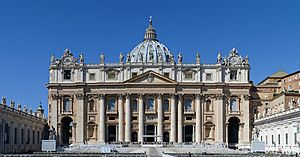
Vatican City is home to some of the most famous art in the world. St. Peter's Basilica is a masterpiece of Renaissance architecture. Many famous artists like Michelangelo helped design it.
The Sistine Chapel is known for its amazing frescos, including Michelangelo's famous ceiling and Last Judgment. Other artists like Raphael also decorated the Vatican's interiors.
The Vatican Apostolic Library and the Vatican Museums hold very important historical, scientific, and cultural collections. In 1984, UNESCO added Vatican City to its list of World Heritage Sites. It's the only entire country on this list!
Science and Learning
The Pontifical Academy of Sciences is located in Vatican City. It brings together scientists from around the world to study math, physics, chemistry, and natural sciences. Famous scientists, including Nobel Prize winners, have been members.
The Pontifical Academy of Social Sciences studies topics like anthropology, economics, and history. The Pontifical Academy for Life focuses on bioethics.
The Vatican Observatory is an astronomical institution. It has telescopes and contributes to astronomy research and education. It also has a large library and a collection of meteorites.
Sports in Vatican City
Vatican City does not compete in the Olympic Games. However, it has participated in some international sporting events. It has its own athletics association called Athletica Vaticana.
Football in Vatican City is organized by the Vatican Amateur Sports Association. They hold a national championship with teams like the Swiss Guard's FC Guardia. Vatican City also has a national football team, but it is not part of major international football organizations like UEFA or FIFA.
Daily Life and Services
Getting Around
Vatican City has a small transport network. It's only about 1 kilometer (0.6 miles) long and 0.85 kilometers (0.5 miles) wide. It does not have airports or highways.
The only aviation facility is the Vatican City Heliport. For air travel, people use the airports in Rome.
Vatican City has a very short railway system. It's mainly used for transporting goods. The closest metro station in Rome is Ottaviano – San Pietro – Musei Vaticani.
Communication and Media
Vatican City has its own modern telephone system. It also has its own Internet top-level domain, which is `.va`.
Vatican Radio broadcasts on different frequencies and online. It was set up by Guglielmo Marconi, a famous inventor. The Vatican Television Center provides TV services.
L'Osservatore Romano is the semi-official newspaper of the Holy See. It reports on official information.
Sending Mail
Vatican City has its own postal system, called Poste Vaticane. It was created in 1929. The state also issues its own postal stamps. Many people say the Vatican's postal service is very efficient.
The international postal code for Vatican City is SCV-00120.
Images for kids
-
Musicians of the British Army's 38th (Irish) Brigade playing in front of St. Peter's Basilica in June 1944
-
Territory of Vatican City State according to the Lateran Treaty
-
Image of the United Nations member state borders on a map
See also
 In Spanish: Ciudad del Vaticano para niños
In Spanish: Ciudad del Vaticano para niños


